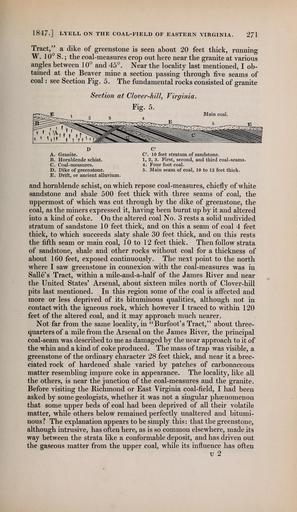MAKE A MEME
View Large Image

| View Original: | The_Quarterly_journal_of_the_Geological_Society_of_London_(13206177714).jpg (1199x2069) | |||
| Download: | Original | Medium | Small | Thumb |
| Courtesy of: | commons.wikimedia.org | More Like This | ||
| Keywords: The Quarterly journal of the Geological Society of London (13206177714).jpg 1847 LYELL ON THE COAL-FIELD OF EASTERN VIRGINIA 2/1 <br> Tract a dike of greenstone is seen about 20 feet thick running <br> W 10° S ; the coal-measures crop out here near the granite at various <br> angles between 10° and 45° Near the locality last mentioned I ob- <br> tained at the Beaver mine a section passing through five seams of <br> coal see Section Fig 5 The fundamental rocks consisted of granite <br> Section at Clover-hill Virginia <br> Fig 5 <br> 2 3 4 <br> A Granite <br> B Hornblende schist <br> C Coal-measures <br> D Dike of greenstone <br> E Drift or ancient alluvium <br> C 10 feet stratum of sandstone <br> 1 2 3 First second and third coal-seams <br> 4 Four foot coal <br> 5 Main seam of coal 10 to 12 feet thick <br> and hornblende schist on which repose coal-measures chiefly of white <br> sandstone and shale 500 feet thick with three seams of coal the <br> uppermost of which was cut through by the dike of greenstone the <br> coal as the miners expressed it having been burnt up by it and altered <br> into a kind of coke On the altered coal No 3 rests a solid undivided <br> stratum of sandstone 1 feet thick and on this a seam of coal 4 feet <br> thick to which succeeds slaty shale 30 feet thick and on this rests <br> the fifth seam or main coal 10 to 12 feet thick Then follow strata <br> of sandstone shale and other rocks without coal for a thickness of <br> about 160 feet exposed continuously The next point to the north <br> where I saw greenstone in connexion with the coal-measures was in <br> Salle's Tract within a mile-and-a-half of the James River and near <br> the United States' Arsenal about sixteen miles north of Clover-hill <br> pits last mentioned In this region some of the coal is aifected and <br> more or less deprived of its bituminous qualities although not in <br> contact with the igneous rock which however I traced to within 1 20 <br> feet of the altered coal and it may approach much nearer <br> Not far from the same locality in Burfoot's Tract about three- <br> quarters of a mile from the Arsenal on the James River the principal <br> coal-seam was described to me as damaged by the near approach to it of <br> the whin and a kind of coke produced The mass of trap was visible a <br> greenstone of the ordinary character 28 feet thick and near it a brec- <br> ciated rock of hardened shale varied by patches of carbonaceous <br> matter resembling impure coke in appearance The locality like all <br> the others is near the junction of the coal-measures and the granite <br> Before visiting the Richmond or East Virginia coal-field I had been <br> asked by some geologists whether it was not a singular phsenomenon <br> that some upper beds of coal had been deprived of all their volatile <br> matter while others below remained perfectly unaltered and bitumi- <br> nous The explanation appears to be simply this that the greenstone <br> although intrusive has often here as is so common elsewhere made its <br> way between the strata like a conformable deposit and has driven out <br> the gaseous matter from the upper coal while its influence has often <br> xj 2 36933010 113687 51125 Page 271 Text v 3 http //www biodiversitylibrary org/page/36933010 1847 Geological Society of London Biodiversity Heritage Library The Quarterly journal of the Geological Society of London v 3 1847 Geology Periodicals Smithsonian Libraries bhl page 36933010 dc identifier http //biodiversitylibrary org/page/36933010 smithsonian libraries Information field Flickr posted date ISOdate 2014-03-17 Check categories 2015 August 26 CC-BY-2 0 BioDivLibrary https //flickr com/photos/61021753 N02/13206177714 2015-08-26 12 55 22 cc-by-2 0 PD-old-70-1923 The Quarterly journal of the Geological Society of London 1847 Photos uploaded from Flickr by Fæ using a script | ||||